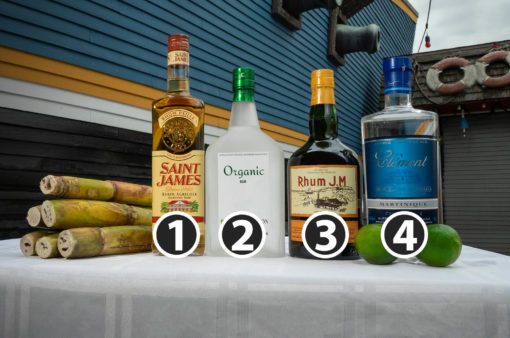Martinique’s most treasured export, rhum agricole is a far cry from all those Bacardi-and-Cokes of your BYGONE YOUTH.
BY Lauren MowerY

1. SAINT JAMES RHUM PAILLE – $24 [40% ABV]
Alcohol and religion go way back, and Saint James was founded in 1765 by priest Father Edmund Lefebure, who exported to British colonies—changing the brand’s original name, Saint Jacques, to appeal to English speakers. Paille refers to the spirit’s straw-yellow color, bestowed by time in oak. On the palate, a pleasing mix of bananas foster, dried fruit and cinnamon spice. Try it in a piña colada.
2. Niesson Organic Rhum – $80 [52.5% ABV]
Billed as the Caribbean’s first certified-organic rhum, this white spirit has extremely limited production, as the man-hours to farm organically far exceed those of conventional practices. Hence its price. Don’t let the clean, bright spirit, imbued with sweet grass, citrus and herbal notes, fool you: It’s over 100 proof. Offers remarkable complexity for an unaged spirit.
3. RHUM J.M. VSOP – $50 [43% ABV]
This house made an early move to distill rhum directly from sugarcane juice, an essential economic move after Martinique’s sugar market collapsed in the nineteenth century. Keeping with tradition, J.M.’s sugarcane comes from the volcanic slopes of Mount Pelée. This Very Superior Old Pale (VSOP) spends three years in bourbon barrels before finishing in American oak. Baking spice, butter and toffee flavors swirl.
4. RHUM CLÉMENT CANNE BLEU – $37 [50% ABV]
Perhaps Martinique’s most famous spirits export, Clément is certainly the busiest tourist distillery. The historic property and lush grounds attract visitors who have seen the brand on shelves at home. Un-aged blanc is at the core of rhum agricole, and Canne Bleu provides great insight into the flavors of single-varietal sugarcane. Steeped in powdered sugar, freshly mowed grass and yellow-citrus notes, the spirit is at once bright and savory.
THROUGH THE appellation system, the French regulate and protect the origins of their Champagne and Cognac, even cheese and chickens. Why not apply the same rigor to rum, or rhum? While mainland France is too cold to grow sugarcane, its overseas department of Martinique is not. In fact, this Caribbean island, also known as Madinina (“island of flowers”), is the key source for the world’s rhum agricole.
Traverse the length of hilly Martinique and you’ll encounter verdant sugarcane fields and the sweet smell of distillation in the air. Rhum agricole is made from freshly crushed sugarcane juice; it is thereby distinct from other rums, which are typically distilled from the byproduct of sugar production, or molasses. Consequently, rhum agricole is an intentional product that’s seasonally dependent.
If an island respite from your practice this summer isn’t in the cards, though, you can always replicate Martinique’s local cocktail, called Ti’ Punch, at home. No recipe required: Just pour a splash of one of these rhums in a glass. Squeeze in lime. Add sugar—not too much; you’re a dentist, after all—and swirl.
LAUREN MOWERY, Incisal Edge’s spirits columnist, has covered the world through the lens of drink for publications including Wine Enthusiast, Forbes and Saveur.
Shot on location at Cooper’s Seafood House
701 North Washington Avenue, Scranton, Pennsylvania
570-346-6883; coopers-seafood.com



